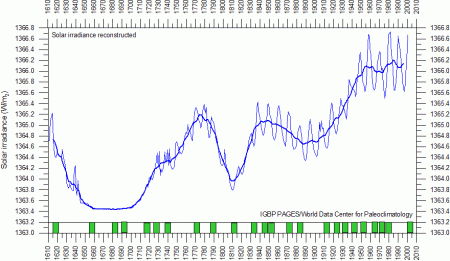“There was a press release from the National Astronomy Meeting – which I go to every couple of years – suggesting that the Sun is will return to Maunder Minimum-like conditions during the 2030s. This has been picked up by some as suggesting that we’re heading for a mini-ice-age.
 “This kind of idea has been addressed before. The basic problem is illustrated in the figure to the right. If the Sun returns to Maunder minimum-like conditions, then that might imply a reduction in Total Solar Irradiance (TSI) of maybe as much as 3Wm-2. However, to determine the corresponding change in forcing requires considering the geometry of the Earth (approximately spherical) and the albedo (about 0.3). A reduction of TSI of 3Wm-2 would produce a change in solar forcing of about 0.5Wm-2.
“This kind of idea has been addressed before. The basic problem is illustrated in the figure to the right. If the Sun returns to Maunder minimum-like conditions, then that might imply a reduction in Total Solar Irradiance (TSI) of maybe as much as 3Wm-2. However, to determine the corresponding change in forcing requires considering the geometry of the Earth (approximately spherical) and the albedo (about 0.3). A reduction of TSI of 3Wm-2 would produce a change in solar forcing of about 0.5Wm-2.
 .
.
“Anthropogenic forcings have, however, probably increased by more than 2Wm-2 since 1750, are currently rising at around 0.4Wm-2/decade, and will probably (unless we start reducing our emissions) continue to rise at at least this rate. A reduction in solar forcing of 0.5Wm-2 by the mid-2030s will therefore only offset about a decade’s worth of increasing anthropogenic forcings. Globally, therefore, the effect will likely be small, as illustrated by the second-to-last figure in this article.
“I should, however, be a little bit careful, as it is possible that such a change in solar forcing could have quite significant regional impacts. This paper suggests that
For a high-end decline in solar ultraviolet irradiance, the impact on winter northern European surface temperatures over the late twenty-first century could be a significant fraction of the difference in climate change between plausible AR5 scenarios of greenhouse gas concentrations.
“So, a return to Maunder minimum-like conditions could have quite large regional impacts, but globally is likely to have a relatively small effect, and would probably only delay global warming by about 10 years” — Posted by: And Then There’s Physics.
Posted on July 12, 2015 by …and Then There’s PhysicsRelated
“There was a press release from the National Astronomy Meeting – which I go to every couple of years – suggesting that the Sun is will return to Maunder Minimum-like conditions during the 2030s. This has been picked up by some as suggesting that we’re heading for a mini-ice-age.
 “This kind of idea has been addressed before. The basic problem is illustrated in the figure to the right. If the Sun returns to Maunder minimum-like conditions, then that might imply a reduction in Total Solar Irradiance (TSI) of maybe as much as 3Wm-2. However, to determine the corresponding change in forcing requires considering the geometry of the Earth (approximately spherical) and the albedo (about 0.3). A reduction of TSI of 3Wm-2 would produce a change in solar forcing of about 0.5Wm-2.
“This kind of idea has been addressed before. The basic problem is illustrated in the figure to the right. If the Sun returns to Maunder minimum-like conditions, then that might imply a reduction in Total Solar Irradiance (TSI) of maybe as much as 3Wm-2. However, to determine the corresponding change in forcing requires considering the geometry of the Earth (approximately spherical) and the albedo (about 0.3). A reduction of TSI of 3Wm-2 would produce a change in solar forcing of about 0.5Wm-2.
 .
.
“Anthropogenic forcings have, however, probably increased by more than 2Wm-2 since 1750, are currently rising at around 0.4Wm-2/decade, and will probably (unless we start reducing our emissions) continue to rise at at least this rate. A reduction in solar forcing of 0.5Wm-2 by the mid-2030s will therefore only offset about a decade’s worth of increasing anthropogenic forcings. Globally, therefore, the effect will likely be small, as illustrated by the second-to-last figure in this article.
“I should, however, be a little bit careful, as it is possible that such a change in solar forcing could have quite significant regional impacts. This paper suggests that
For a high-end decline in solar ultraviolet irradiance, the impact on winter northern European surface temperatures over the late twenty-first century could be a significant fraction of the difference in climate change between plausible AR5 scenarios of greenhouse gas concentrations.
“So, a return to Maunder minimum-like conditions could have quite large regional impacts, but globally is likely to have a relatively small effect, and would probably only delay global warming by about 10 years” — Posted by: And Then There’s Physics.
Posted on July 12, 2015 by …and Then There’s Physics
